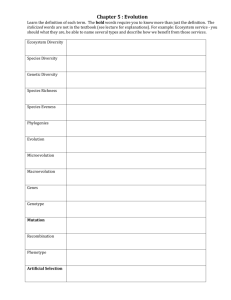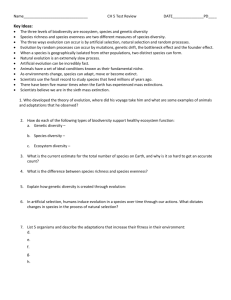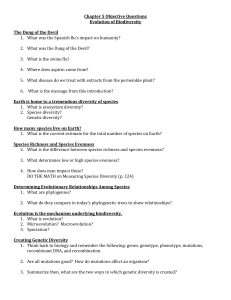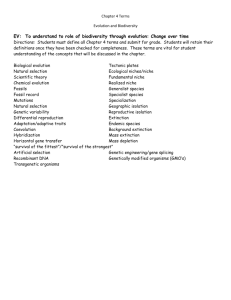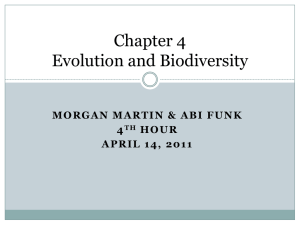chapter 5 Glossary - CarrollEnvironmentalScience
advertisement
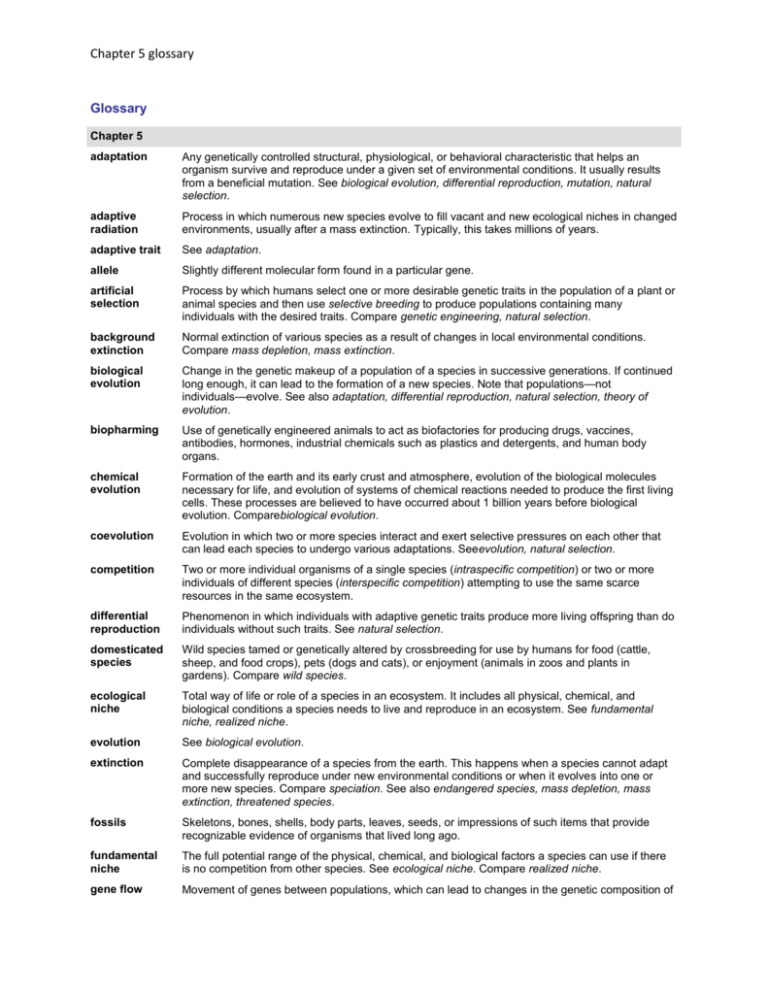
Chapter 5 glossary Glossary Chapter 5 adaptation Any genetically controlled structural, physiological, or behavioral characteristic that helps an organism survive and reproduce under a given set of environmental conditions. It usually results from a beneficial mutation. See biological evolution, differential reproduction, mutation, natural selection. adaptive radiation Process in which numerous new species evolve to fill vacant and new ecological niches in changed environments, usually after a mass extinction. Typically, this takes millions of years. adaptive trait See adaptation. allele Slightly different molecular form found in a particular gene. artificial selection Process by which humans select one or more desirable genetic traits in the population of a plant or animal species and then use selective breeding to produce populations containing many individuals with the desired traits. Compare genetic engineering, natural selection. background extinction Normal extinction of various species as a result of changes in local environmental conditions. Compare mass depletion, mass extinction. biological evolution Change in the genetic makeup of a population of a species in successive generations. If continued long enough, it can lead to the formation of a new species. Note that populations—not individuals—evolve. See also adaptation, differential reproduction, natural selection, theory of evolution. biopharming Use of genetically engineered animals to act as biofactories for producing drugs, vaccines, antibodies, hormones, industrial chemicals such as plastics and detergents, and human body organs. chemical evolution Formation of the earth and its early crust and atmosphere, evolution of the biological molecules necessary for life, and evolution of systems of chemical reactions needed to produce the first living cells. These processes are believed to have occurred about 1 billion years before biological evolution. Comparebiological evolution. coevolution Evolution in which two or more species interact and exert selective pressures on each other that can lead each species to undergo various adaptations. Seeevolution, natural selection. competition Two or more individual organisms of a single species (intraspecific competition) or two or more individuals of different species (interspecific competition) attempting to use the same scarce resources in the same ecosystem. differential reproduction Phenomenon in which individuals with adaptive genetic traits produce more living offspring than do individuals without such traits. See natural selection. domesticated species Wild species tamed or genetically altered by crossbreeding for use by humans for food (cattle, sheep, and food crops), pets (dogs and cats), or enjoyment (animals in zoos and plants in gardens). Compare wild species. ecological niche Total way of life or role of a species in an ecosystem. It includes all physical, chemical, and biological conditions a species needs to live and reproduce in an ecosystem. See fundamental niche, realized niche. evolution See biological evolution. extinction Complete disappearance of a species from the earth. This happens when a species cannot adapt and successfully reproduce under new environmental conditions or when it evolves into one or more new species. Compare speciation. See also endangered species, mass depletion, mass extinction, threatened species. fossils Skeletons, bones, shells, body parts, leaves, seeds, or impressions of such items that provide recognizable evidence of organisms that lived long ago. fundamental niche The full potential range of the physical, chemical, and biological factors a species can use if there is no competition from other species. See ecological niche. Compare realized niche. gene flow Movement of genes between populations, which can lead to changes in the genetic composition of Chapter 5 glossary local populations. gene mutation See mutation. gene pool The sum total of all genes found in the individuals of the population of a particular species. gene splicing See genetic engineering. generalist species Species with a broad ecological niche. They can live in many different places, eat a variety of foods, and tolerate a wide range of environmental conditions. Examples are flies, cockroaches, mice, rats, and human beings. Compare specialist species. genetic adaptation Changes in the genetic makeup of organisms of a species that allow the species to reproduce and gain a competitive advantage under changed environmental conditions. See differential reproduction, evolution, mutation, natural selection. genetic engineering Insertion of an alien gene into an organism to give it a beneficial genetic trait. Compare artificial selection, natural selection. genetically modified organism (GMO) Organism whose genetic makeup has been modified by genetic engineering. geographic isolation Separation of populations of a species for long times into different areas. habitat Place or type of place where an organism or population of organisms lives. Compare ecological niche. macroevolution Long-term, large-scale evolutionary changes among groups of species. Compare microevolution. mass depletion Widespread, often global period during which extinction rates are higher than normal but not high enough to classify as a mass extinction. Comparebackground extinction, mass extinction. mass extinction A catastrophic, widespread, often global event in which major groups of species are wiped out over a short time compared with normal (background) extinctions. Compare background extinction, mass depletion. microevolution The small genetic changes a population undergoes. Compare macroevolution. mutagen Chemical or form of radiation that causes inheritable changes (mutations) in the DNA molecules in the genes found in chromosomes. See carcinogen, mutation, teratogen. mutation A random change in DNA molecules making up genes that can yield changes in anatomy, physiology, or behavior in offspring. See mutagen. natural rate of extinction See background extinction. natural selection Process by which a particular beneficial gene (or set of genes) is reproduced in succeeding generations more than other genes. The result of natural selection is a population that contains a greater proportion of organisms better adapted to certain environmental conditions. See adaptation, biological evolution, differential reproduction, mutation. niche See ecological niche. realized niche Parts of the fundamental niche of a species that are actually used by that species. See ecological niche, fundamental niche. reproductive isolation Long-term geographic separation of members of a particular sexually reproducing species. specialist species Species with a narrow ecological niche. They may be able to live in only one type of habitat, tolerate only a narrow range of climatic and other environmental conditions, or use only one type or a few types of food. Compare generalist species. speciation Formation of two species from one species because of divergent natural selection in response to changes in environmental conditions; usually takes thousands of years. Compare extinction. theory of Widely accepted scientific idea that all life forms developed from earlier life forms. Although this Chapter 5 glossary evolution transgenic organisms theory conflicts with the creation stories of many religions, it is the way biologists explain how life has changed over the past 3.6-3.8 billion years and why it is so diverse today. See genetically modified organisms (GMOs). water table Upper surface of the zone of saturation, in which all available pores in the soil and rock in the earth's crust are filled with water. wild species Species found in the natural environment. Compare domesticated species.


